Construction Progress 2021
DESIGN AND MANUFACTURING PROGRESS REPORTS 2021
Late December 2021 - Photos of Wheels patterns and Computer Simulations
Whilst on a visit last week (16th December) to William Cook's premises in Sheffield, our chairman took some photos of the wheel patterns, which were being prepared to create the casting moulds. He was also shown the computer simulations which showed the pouring, the cooling and estimates the shrinkage likely to occur, using a program called MagmaFlow. Casting is scheduled to commence in January.
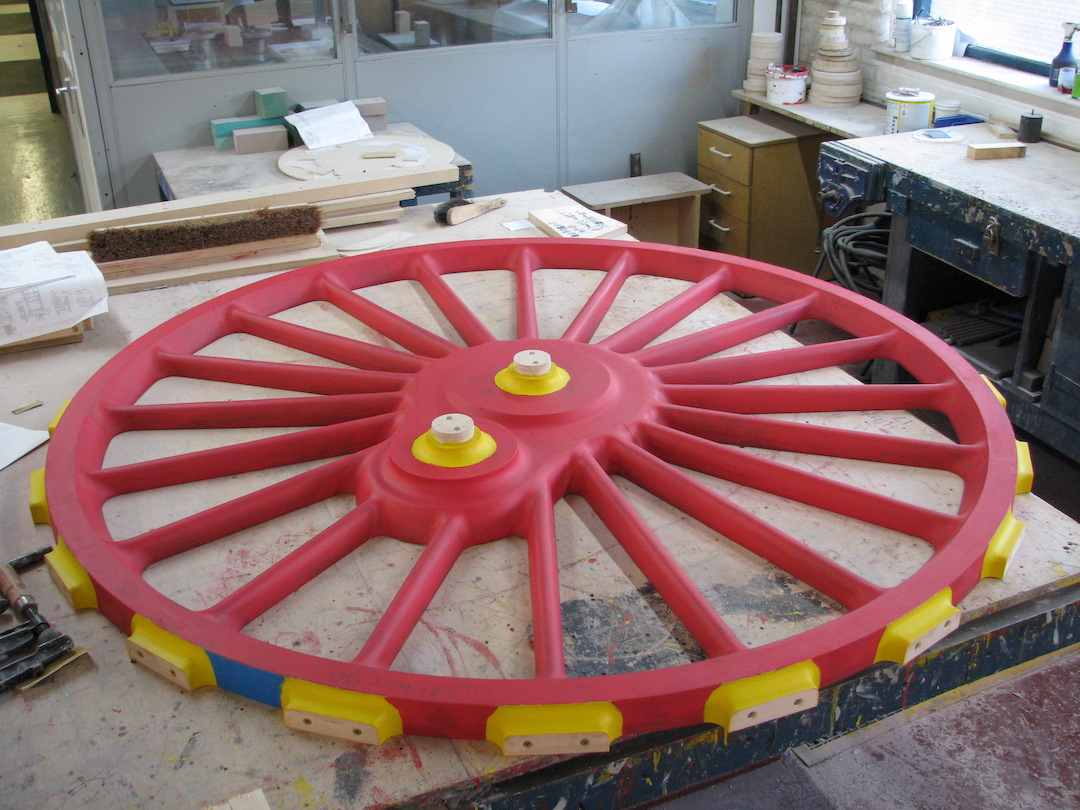 |
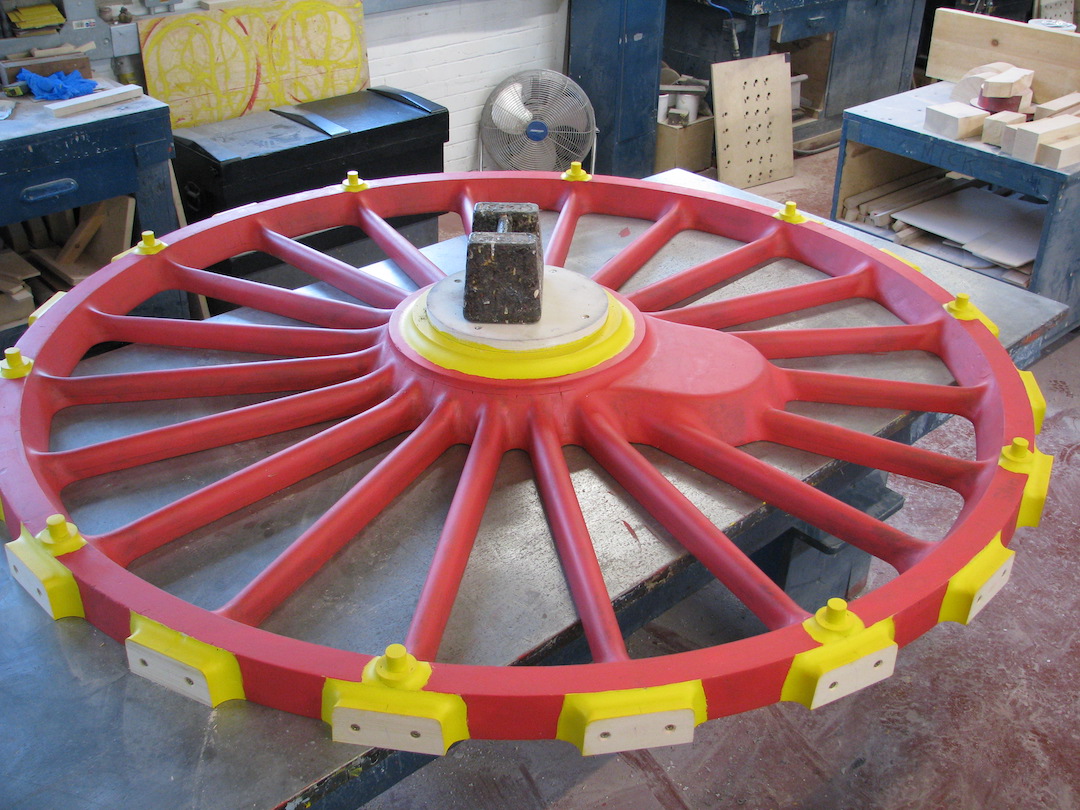 |
 |
| Front and Back faces of the wheel pattern | Showing wooden bases for Blind Side Feeders which are fitted to the rim of the wheel pattern | |
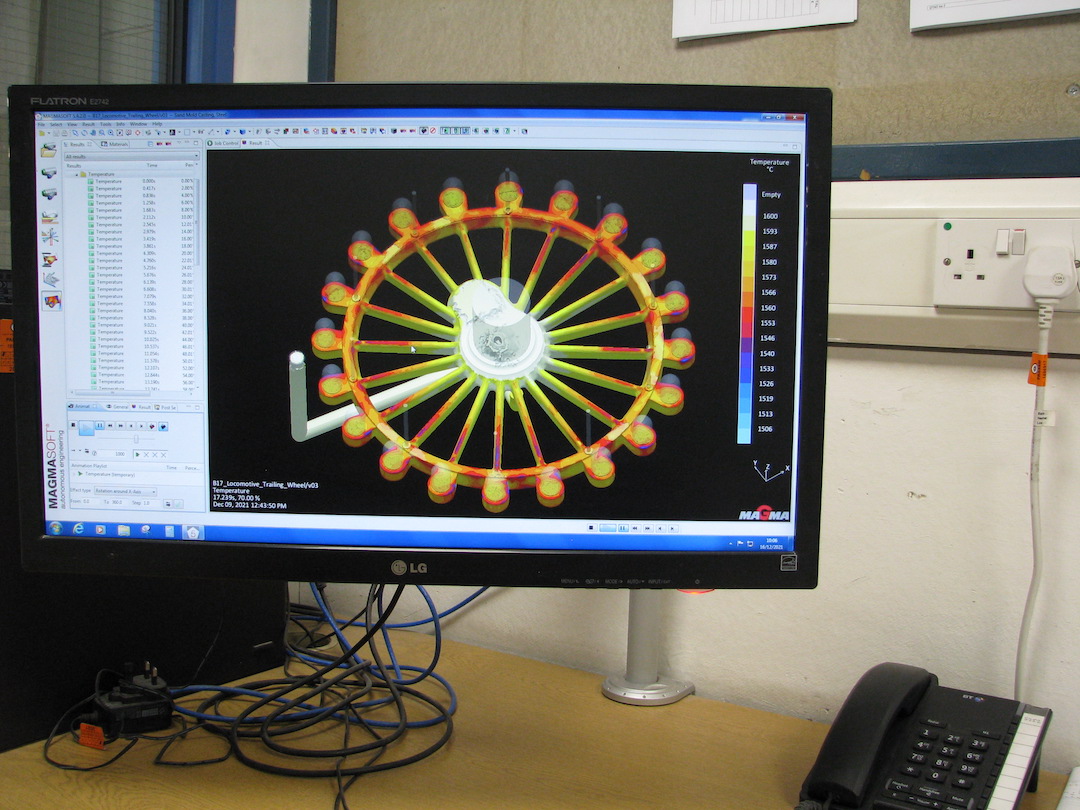 |
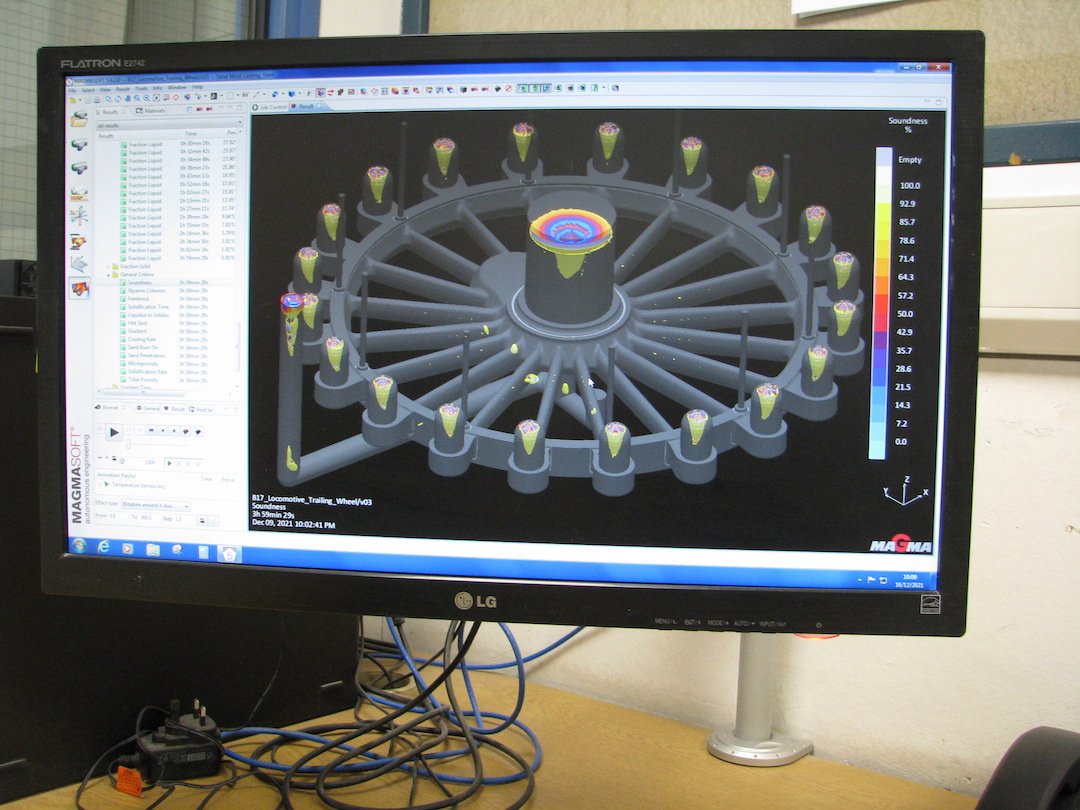 |
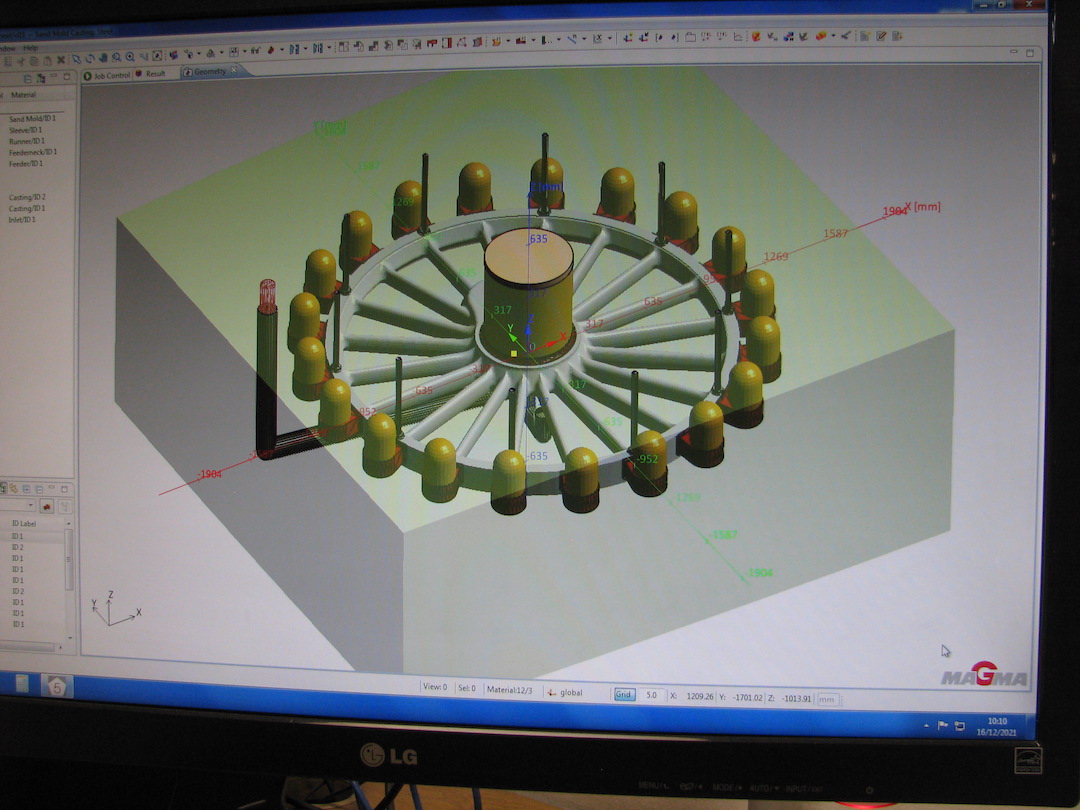 |
| Commence cooling 1560 degrees C Red/Yellow | Shrinkage Indicator on cooling. | Model wheel in sand (contained in Moulding Box profile) |
December 2021
Manufacturing orders have been placed with William Cook Cast Products Ltd (WCCP) for the six 6'8" Driving Wheels. These castings will be using the same wheel pattern as used for Tornado's wheels, the patterns having been loaned to us by the A1 Steam Locomotive Trust, whose generous help is gratefully acknowledged. The wheel pattern is being prepared in the Pattern Shop at WCCP. Each wheel will be subject to additional Non Destructive Testing (NDT) using a combination of Radiographic (X-ray) and Ultrasound Tests, once cast, to provide greater assurance and integrity in the product. The order follows recent Coupled Axlebox castings and two Cannon Axlebox castings, also by William Cook Cast Products of Sheffield.
November 2021
A resume: Work on 61673 started when the frames were cut in 2015 and we were based in Llangollen. In 2020, we moved to the premises of CTL Seal in Sheffield and are currently involved in the manufacture of the Rolling Chassis. Although nothing was left of the locomotives, we were fortunate to acquire 2 tenders – a GER pattern one and an LNER pattern one. These were originally stored at Dereham on the MNR but were moved to Sheffield in August 2020.
Whilst we were always intent on building our loco (Spirit of Sandringham) for mainline use, another Group also started on making a replica of another member of the B17 Class. This was the 61662 Manchester United Project and their ‘mock up’ was based at the Mizens Railway site near Woking. Earlier this year, this group decided to abandon the Project and dismantled the life size model they had created. Behind the model of the locomotive was a real LNER Pattern tender – one of the type pulled by B17s. The Group have generously donated this Tender to the Trust and it has just been transported to our engineering base in Sheffield on 30th November and 1st December – see the photos below.
Now in Sheffield, it is stored alongside our other 2 tenders. We are currently working on Grant Applications which will enable us to strip the existing tenders, identify what can be re-used and hopefully start on the build for a refurbished tender. This work will be carried out by apprentices under supervision and so will form an integral part of their Training Programme.
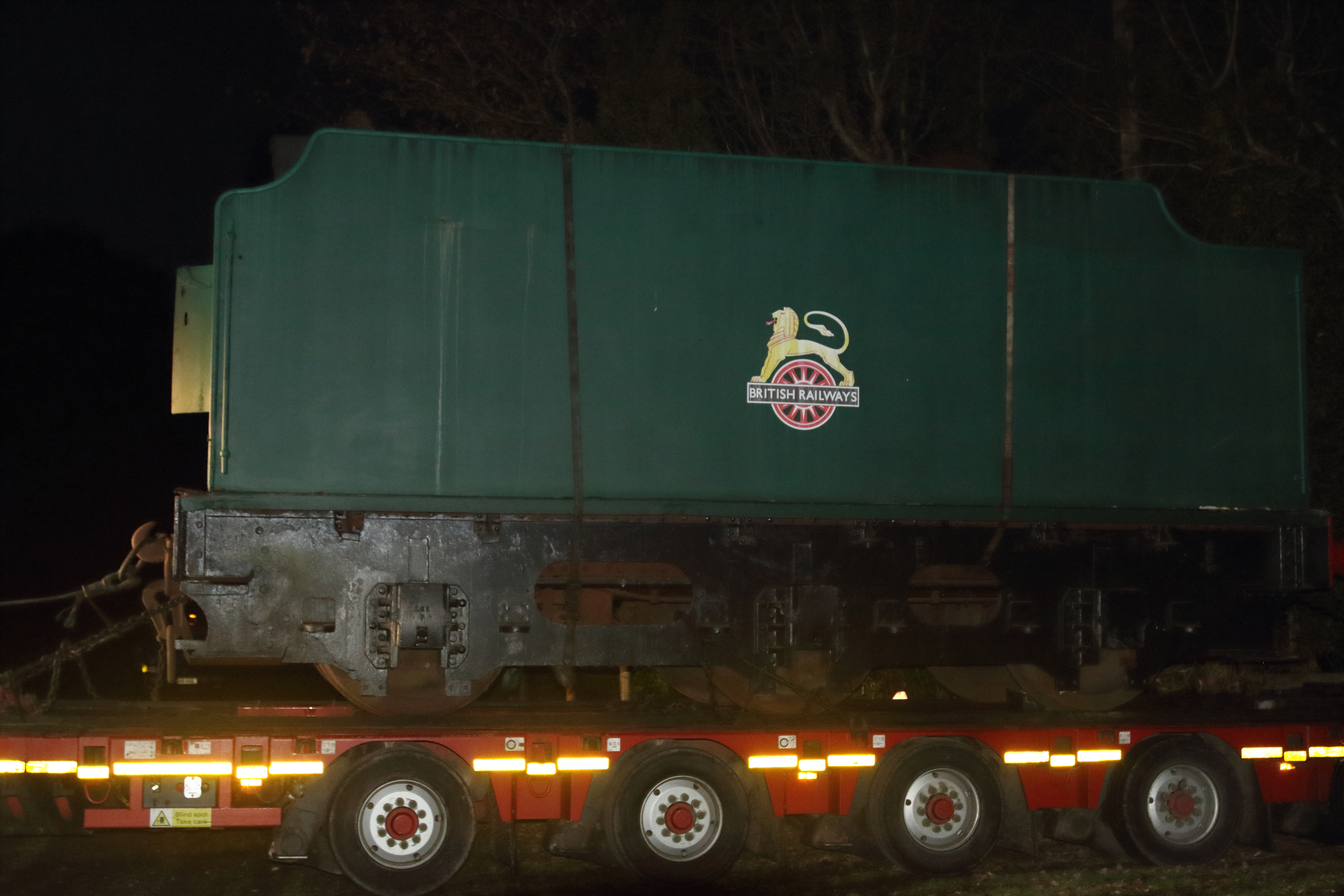 |
30th November 2021. The LNER Tender loaded up and ready to go north. |
| Working in the late afternoon, Stuart Smith worked to get the tender loaded onto his trailer. This photo shows him doing the final checks before leaving for the journey north to our base in Sheffield. | 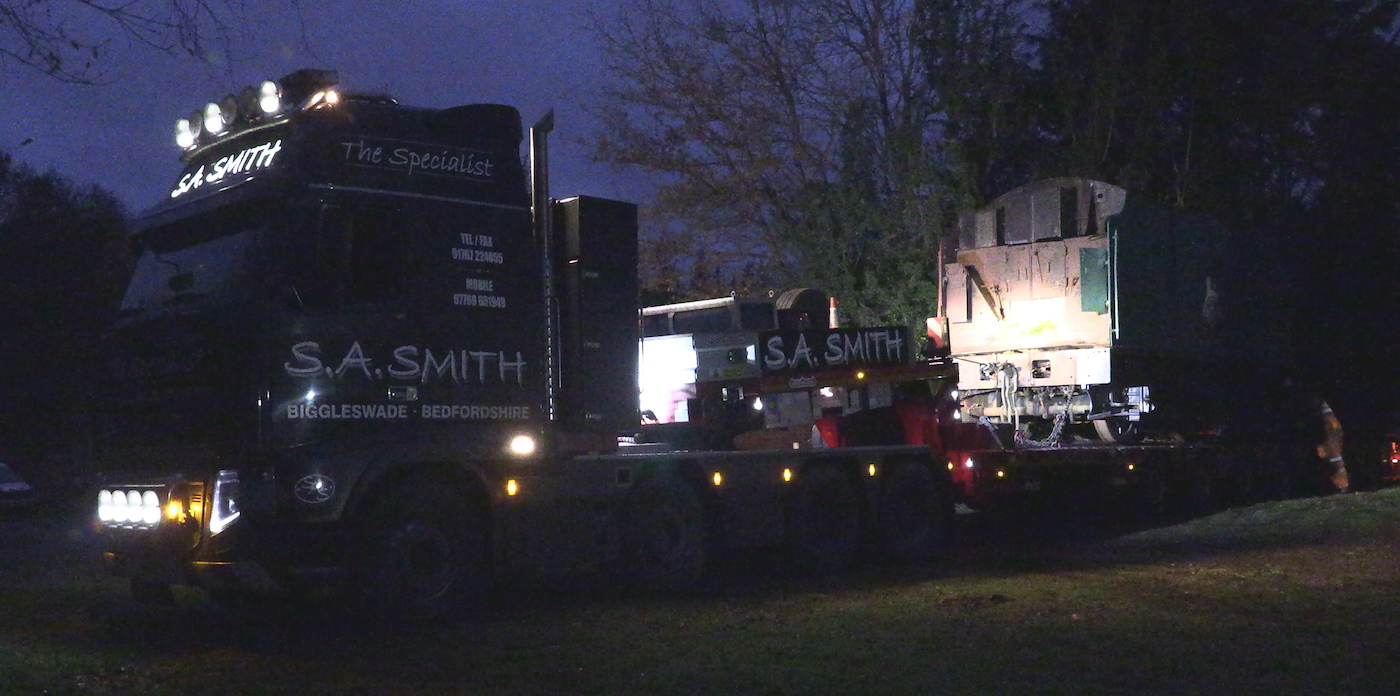 |
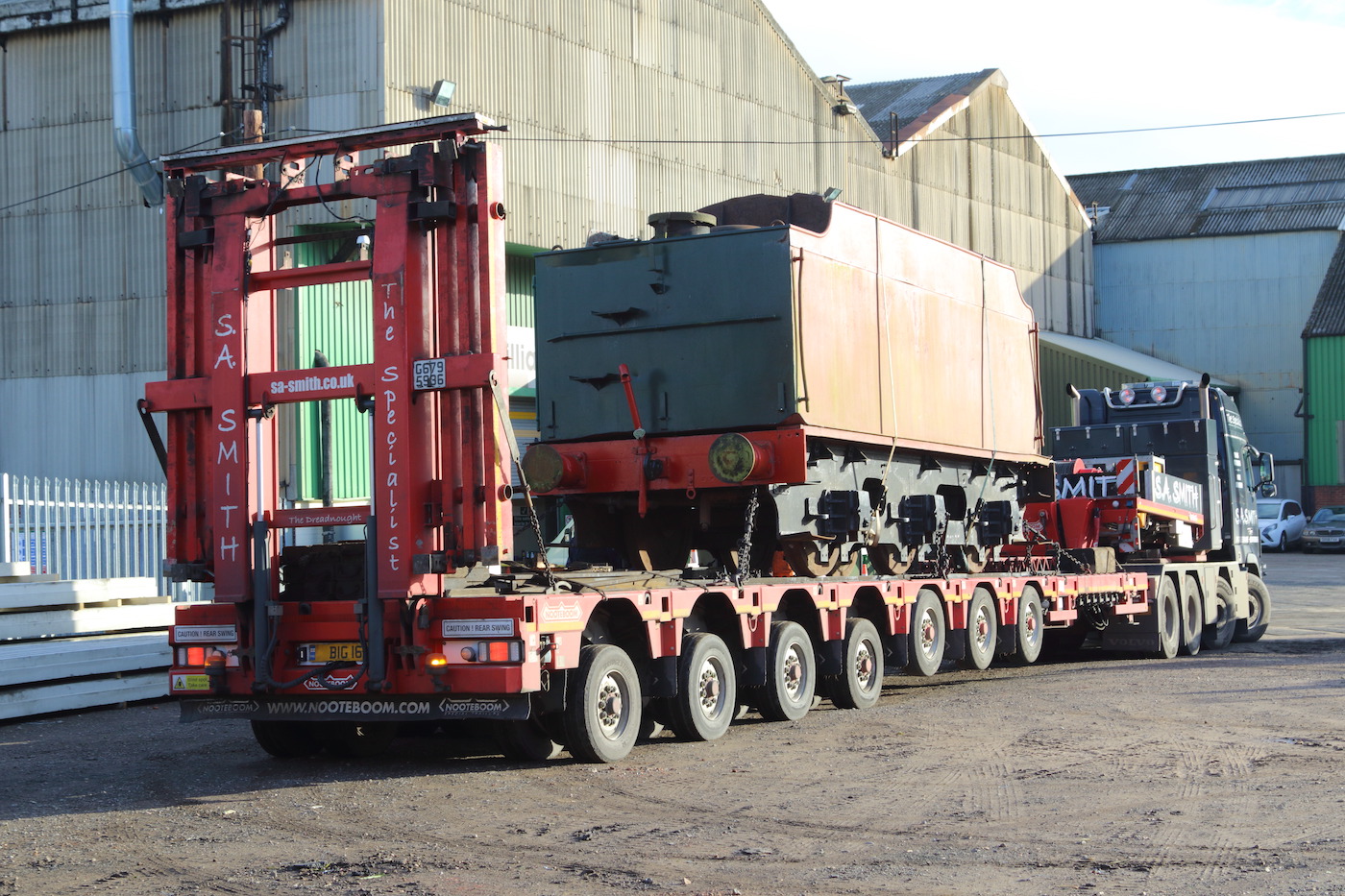 |
The next day, 1st December 2021, the load has arrived at our base at CTL Seal in Sheffield. |
| The rails on the trailer were connected to the panel of track we had laid, we were ready to unload the tender. |  |
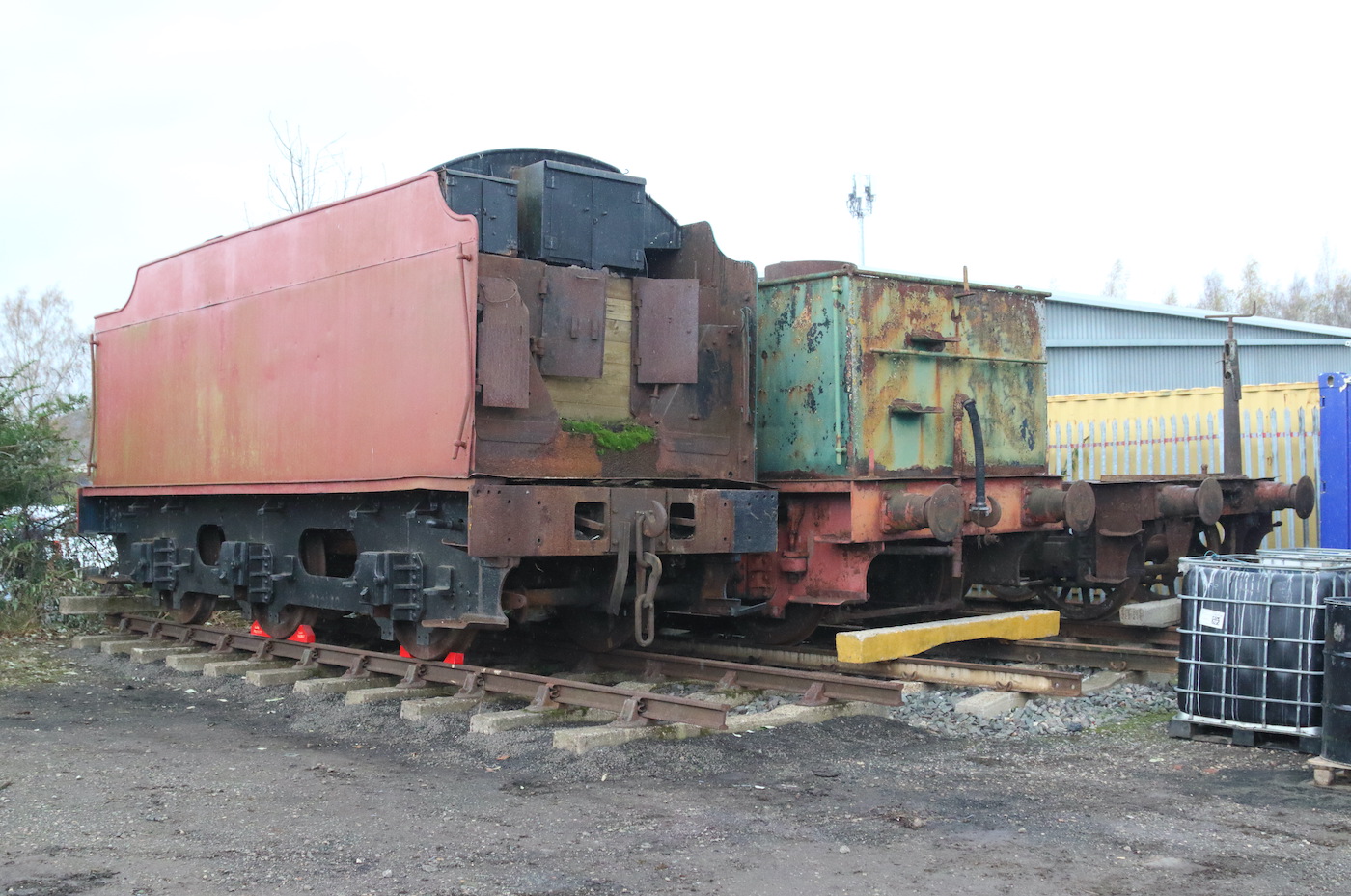 |
Finally in place, the tender donated by the 61662 Manchester United project as part of the project being wound up, the lineup of the three tenders shows the scope we now have for creating a tender capable of running on the mainline. The '61662' tender number is 4166, built at Vulcan Foundry and was paired with B1 61176. The other LNER designed tender (middle) started life behind a J39 64961 tender no 7163, marked on axle boxes, Withdrawn at Lincoln in 1959 and recovered to Cambridge, it became an oil and sludge carrier at Cambridge before moving to the NNR. Our original GER tender has 2802 stamped on the running gear; this was the first B17 in service. All photos in this series by Tony Brzosko |
August 2021
William Cook Cast products have completed the casting of the Coupled Axleboxes and the Cannonbox sections ordered, as reported, last month. It is interesting to compare the actual castings with the CAD images illustrated earlier.
The patterns shown below have been kindly loaned to B17 by the A1 Steam Locomotive Trust, whose generous help is gratefully acknowledged.
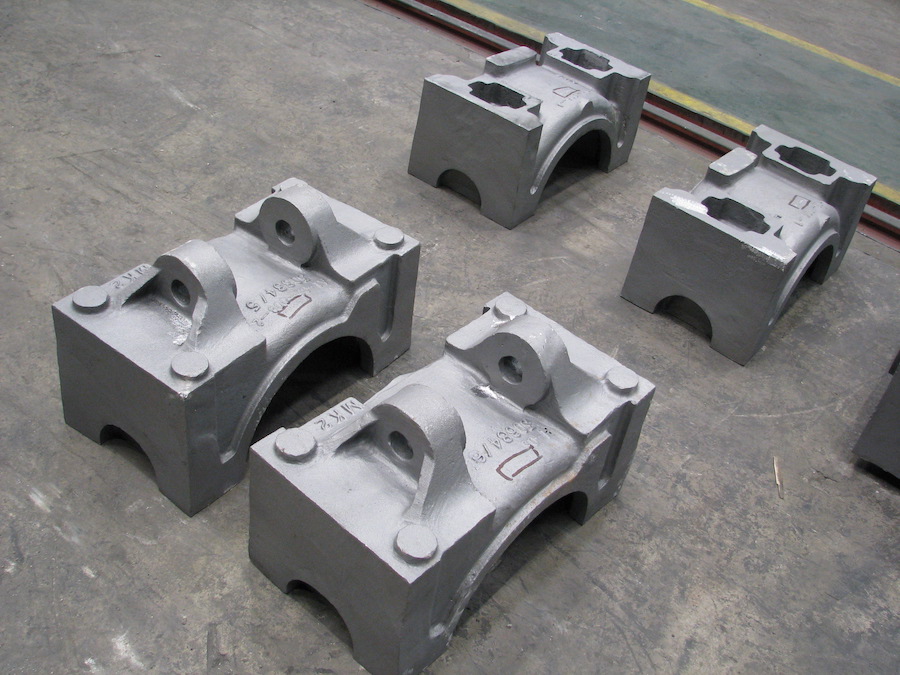 |
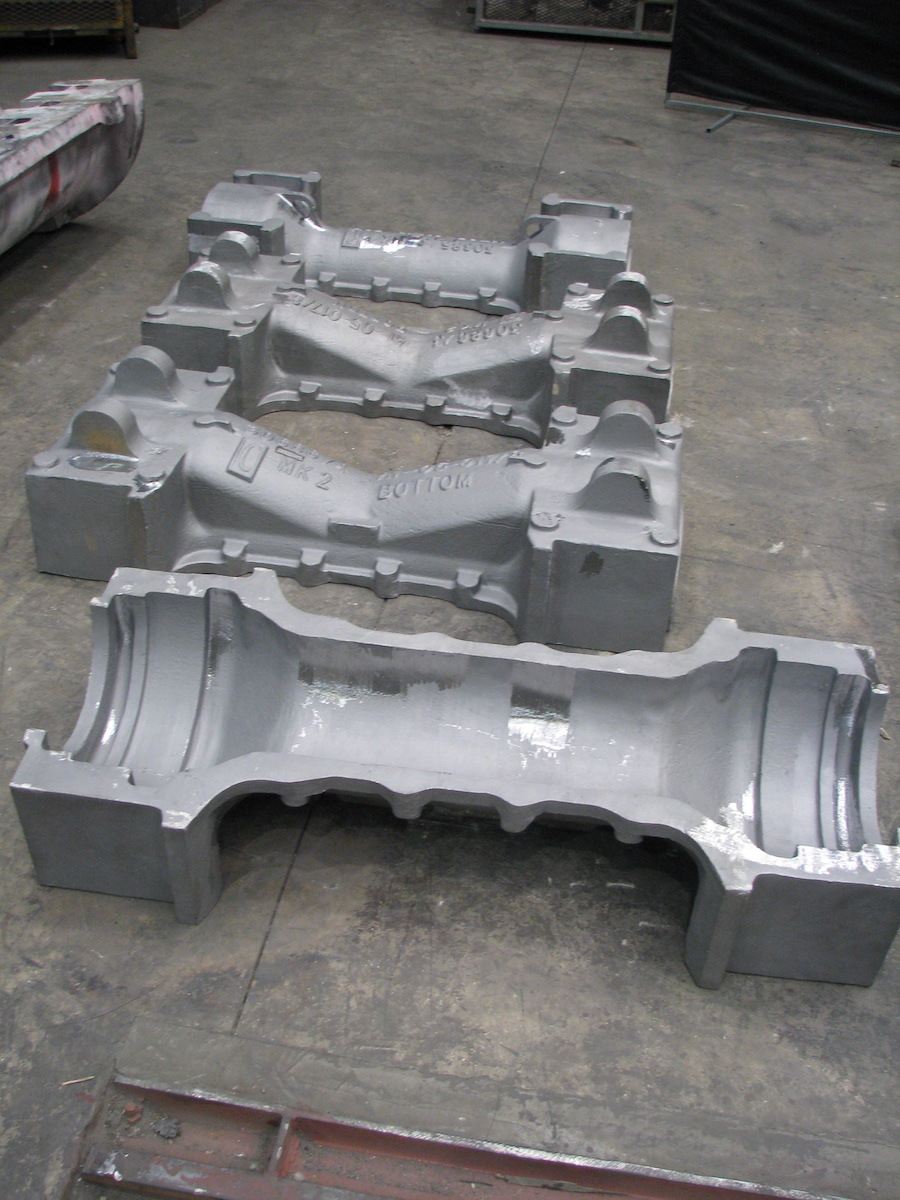 |
| Coupled Axlebox (Leading Axle) | Cannon Boxes (Intermediate/Driving and Trailing Axles) |
Work will now commence on checking the wheel patterns before casting these.
July 2021
Orders for the Manufacture of Steel Castings for Timken Roller Bearings
Manufacturing orders have been placed for two Coupled Axlebox castings and two Cannon Box castings with William Cook Cast Products of Sheffield, for completion by early November of this year. Each casting set is made up of a top and bottom half. Patterns for each casting set have been successfully used for both A1 Tornado and the P2 Prince of Wales. The patterns shown below have been kindly loaned to B17 by the A1 Steam Locomotive Trust, whose generous help is gratefully acknowledged.
 |
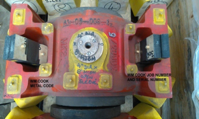 |
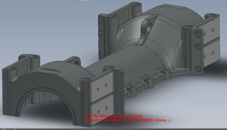 |
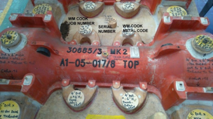 |
 |
 |
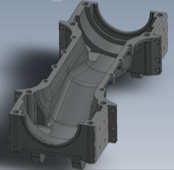 |
 |
| Coupled Axlebox (Leading Axle) | Cannon Box (Intermediate/Driving and Trailing Axles) | ||
Roller bearings were first trialled by the Big Four during the 1930s when they were initially fitted to locomotive tenders. The LMS then made the first bold move to introduce roller bearings on their turbine locomotive No. 6202, to be followed soon afterwards by a further application on the trailing trucks of five “Princess Royal” class Pacifics. Next, the LNER converted two class A4 tenders to roller bearings, but any further developments were suspended when war intervened. All had proved successful and by 1947 the LMS equipped new build Class 5s with Timken roller bearings on all driving axles and carrying axles. The same locomotives were also fitted with different types of valve gear to provide a broad set of trials in the post war era. By 1948, the LNER introduced Timken roller bearings to a batch of five Peppercorn class A1s (BR Nos. 60153 -7) under construction at Doncaster. These proved successful and forms the basis of the design illustrated and will be used for Spirit of Sandringham.
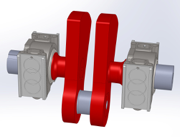 |
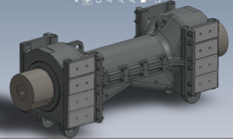 |
| Leading Axle showing both coupled axleboxes containing Timken Roller Bearings mounted on each stub axle. | Cannon Box containing Timken Roller Bearings mounted on each end of the plain axle for the Intermediate (Driving) and Trailing Axle. |
June 2021
A Tender behind – and then there were three!!
Readers will recall that we moved our original two tenders from the Mid Norfolk Railway in Dereham to CTL Seal’s premises in Sheffield as part of the 'Big Move' last year. Subsequently, the Manchester United Project to recreate a 'mock up' of the B17 Locomotive of the same name was terminated; this was located in the grounds of the Woking Miniature Railway in Surrey.
The Group responsible for this Project kindly donated the tender and various sundry items to the B17 SLT for which we are very grateful. When Brian Hall, our Chairman, first visited the site it was clear that the 'mock up' of the engine had to be dismantled before we could gain access to the tender and the section of track which we had been given. We asked to be advised when we might gain access for the removal of our items.
Thus it was that a second visit was made to the site on Friday 11th June, in order to see if we could gain access now that the ‘engine’ had been dismantled. We met Stuart Smith, our Haulage Contractor, on siteto discuss arrangements for the move. After inspection, it was decided that Stuart would send down one truck to remove the track and the sundry items (including another pair of buffers), taking them to Sheffield. He would then supply a second truck, approx. one week later, in order to move the tender. This would allow us to assemble the track in Sheffield before placing the tender on it.
|
The 61662 Project tender with Stuart Smith and Brian Hall discussing the options. Photo by Larry Sampson |
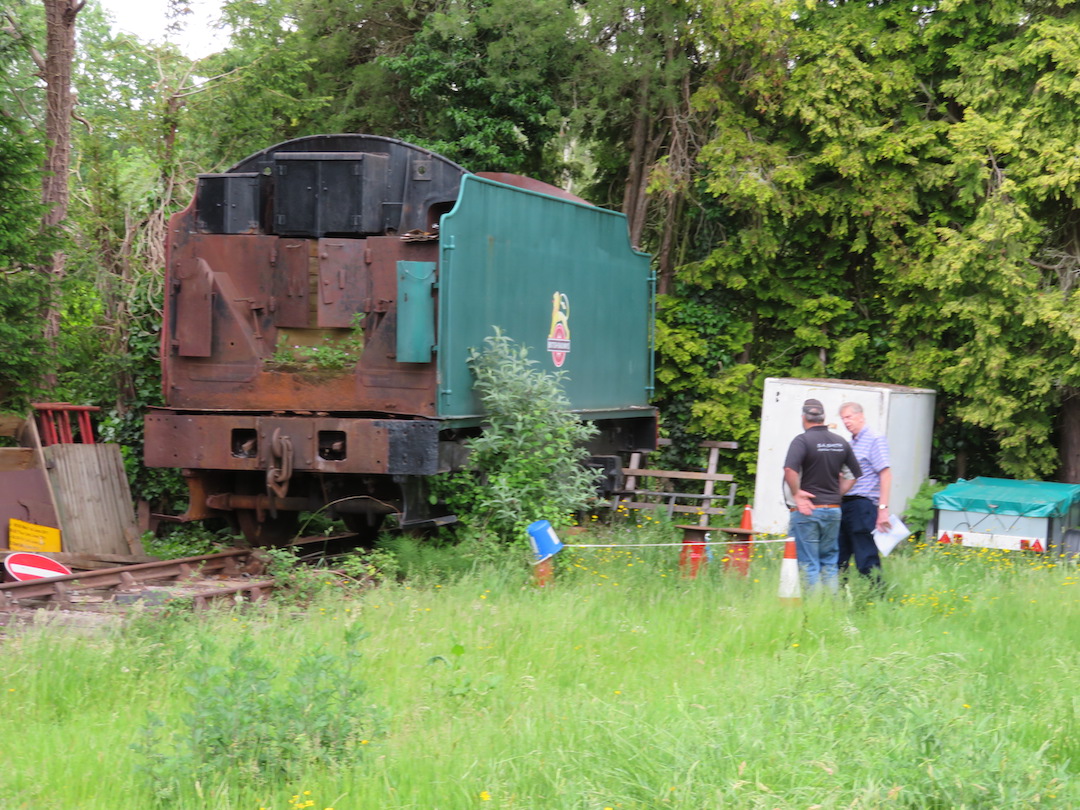 |
Hopefully we will end up with all 3 tenders side by side – is this the largest collection of possible B17 Tenders in one place? I am sure that they will all give up useful parts for the new Spirit of Sandringham tender.
May 2021
Following on from the delivery of the cast Hornblocks by William Cook’s to our engineering base at CTL Seal as previously reported for April, the Trust is pleased to report the next stage of the Rolling Chassis has commenced. With the easing of the Coronavirus lockdown rules, the patterns for the Cannon Axle boxes and the Coupled Axle boxes, along with the patterns for the 6’8” driving wheels, have been collected from their various storage areas in Darlington and delivered to the William Cook premises in Sheffield for casting.
Casting of these items will proceed whilst the Hornblocks are machined and fitted to the chassis at CTL Seal Ltd.
Our thanks go to the A1 Steam Locomotive Trust for the loan of these patterns.As mentioned in the January Update, you will be aware that the Hornblocks have been cast at the premises of William Cook Cast Products in Sheffield. They have now been released and delivered to our construction site at CTL Seal in Sheffield, where they will be machined and fitted to the chassis.
| Hornblocks at CTL Seal | 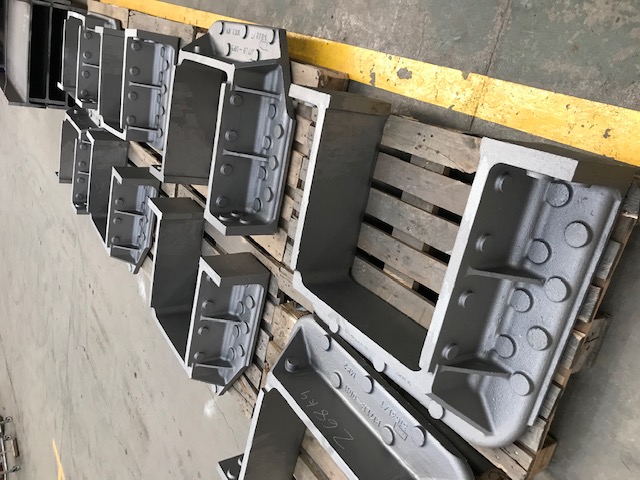 |
In the meantime, the patterns for the Cannon Axle box and the Coupled Axles are being prepared for delivery to William Cook's, where these items will be cast.
It is possible some members will not be sure exactly where these castings go on the locomotive so hopefully the diagram below gives some clarification. The hornblocks are shown in yellow.
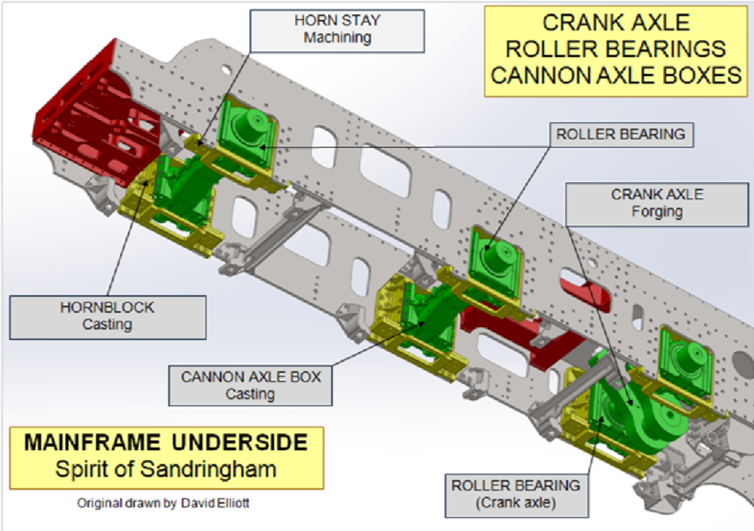
The Next Castings
With the kind permission and help of the A1 Steam Locomotive Trust and William Cook Cast Products, arrangements are being planned to prepare the existing patterns for the Coupled Axleboxes and Cannon Axle boxes to be transported from storage in Darlington “Loco Works” to Sheffield. However, the pattern for the coupled wheel used for Tornado remains on display in the “Head of Steam” Museum at North Road Station, Darlington. Public access to the museum is severely restricted meaning that our ability to remove the pattern is likely to be delayed until a relaxation in restrictions is introduced and access is granted by the Local Authority (Darlington Borough Council). Pattern recovery will involve members of the A1 SLT and B17 SLT, to be conducted when Covid infection rates are low and a safer working environment is more certain and appropriate permission received.
ENGINEERING DEVELOPMENT
Inside Cylinder
The shape of the inside cylinder is similar to that of the outside cylinders but its location, fitted between the frames, is much further forward, situated above the front bogie axle shown on the illustration of the front end of the engine. The off-set of the steam chest towards the left hand side of the engine (when facing forward) is clearly visible on the front view. Detailed design work on all three cylinders will be combined to produce fabricated structures using appropriate welding techniques and materials providing greater strength compared with traditional castings. CAD technology will be used to define the complex set of fabricated shapes as discrete sub-assemblies and the order of integration to build up each cylinder structure, which in turn will define the sequential stages of assembly. This will deliver significant savings in pattern design and manufacturing costs that would otherwise be required for each of the three cylinders in turn. The fabricated design of the saddle will follow.
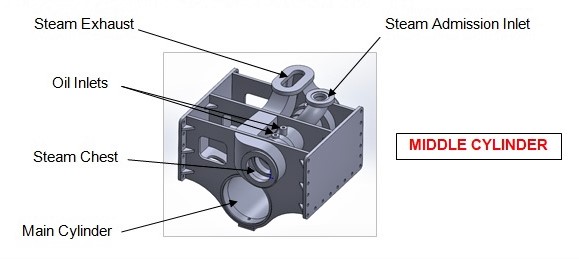

Springs
The revised design of the main leaf springs (arrowed) can be seen on the right hand side of the engine shown tilted in the top view and the section through the frame structure lower view.
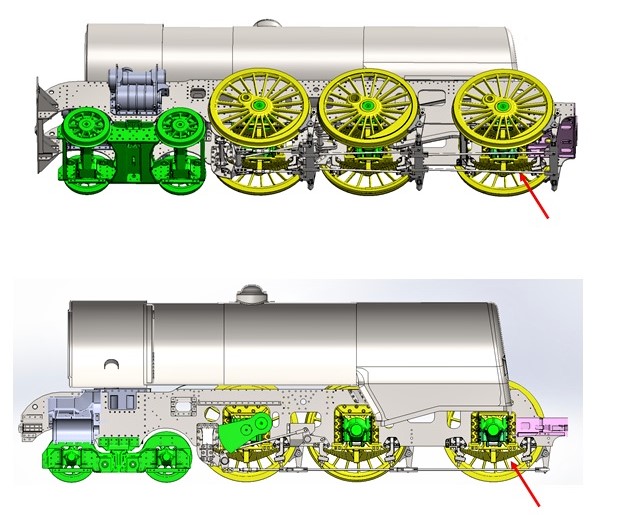 Detail drawings are currently being reviewed by Owen Springs Ltd of Rotherham to provide their quotation. This company are experts in their field for the heritage sector, having acquired much of the manufacturing kit, test equipment and technical data including drawings and material specifications from the former BR Workshops at Eastleigh and Derby, upon their closure in the 1960s. Doubtless a real set of gems!
Detail drawings are currently being reviewed by Owen Springs Ltd of Rotherham to provide their quotation. This company are experts in their field for the heritage sector, having acquired much of the manufacturing kit, test equipment and technical data including drawings and material specifications from the former BR Workshops at Eastleigh and Derby, upon their closure in the 1960s. Doubtless a real set of gems!
We are most grateful to Alan Parkin and David Elliott, who jointly provide the engineering design expertise in researching and producing the 3D illustrations and component drawings using the Solidworks system for the cylinders and springs.
SO TO SUMMARISE, WHAT’S NEXT IN 2021?
Once we have the patterns from Darlington and the quotations from CTL Seal, the Trust can move forward with:
- Machining and fitting the hornblocks (these will shortly be moved from William Cook’s premises to those of CTL Seal). Includes the manufacture of hornblock linings.
- Set up of the frame structure to conduct straightness and measurement checks (using laser based equipment).
In the meantime the Trust will, as soon as the Coronavirus restrictions allow:
- Move the cannonbox and the coupled axlebox patterns from their location at the A1 Steam Locomotive Trust’s premises in Darlington, to William Cook’s in Sheffield and cast.
- Similarly, move the wheel pattern from storage at the Museum in Darlington, to William Cook’s premises and cast.
Once cast and released, the next tasks are:
- Machining and fitting the cannonbox and coupled axlebox castings.
- Manufacturing horn stays.
All of the above is achievable in 2021 but dependent on both the lifting of movement restrictions and funding. In the meantime, detailed design work will continue.
All of the above is achievable in 2021 but dependent on both the lifting of movement restrictions and funding. In the meantime, detailed design work will continue.
Late January 2021
 |
This CAD drawing shows the location of the left hand and middle cylinders, together with the front bogie. | |
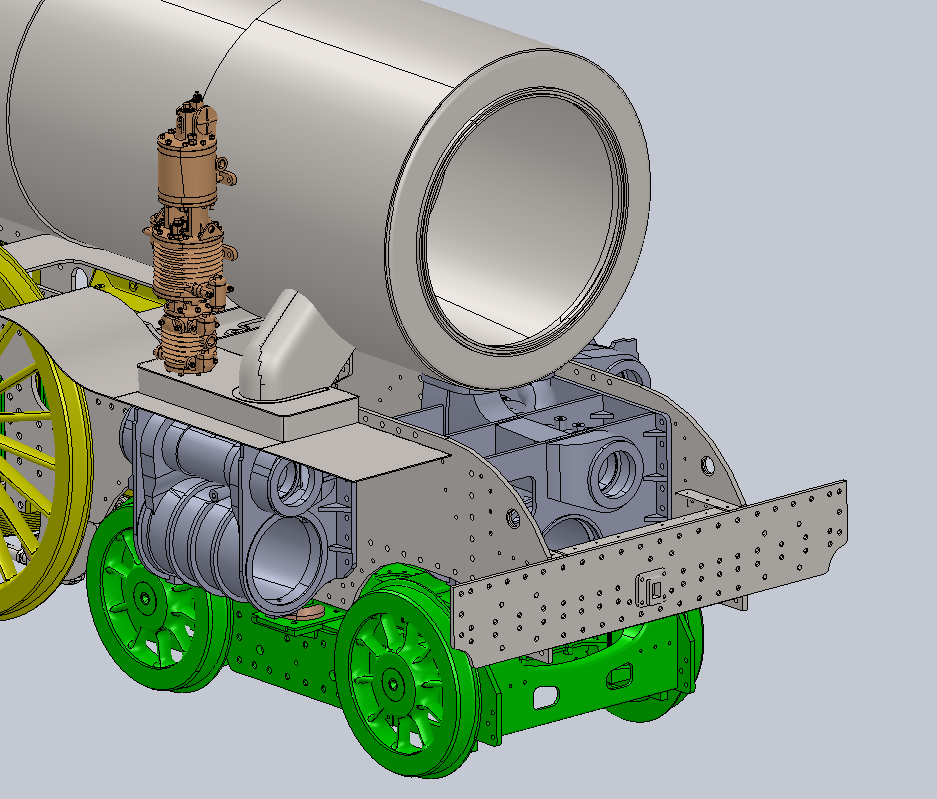 |
 |
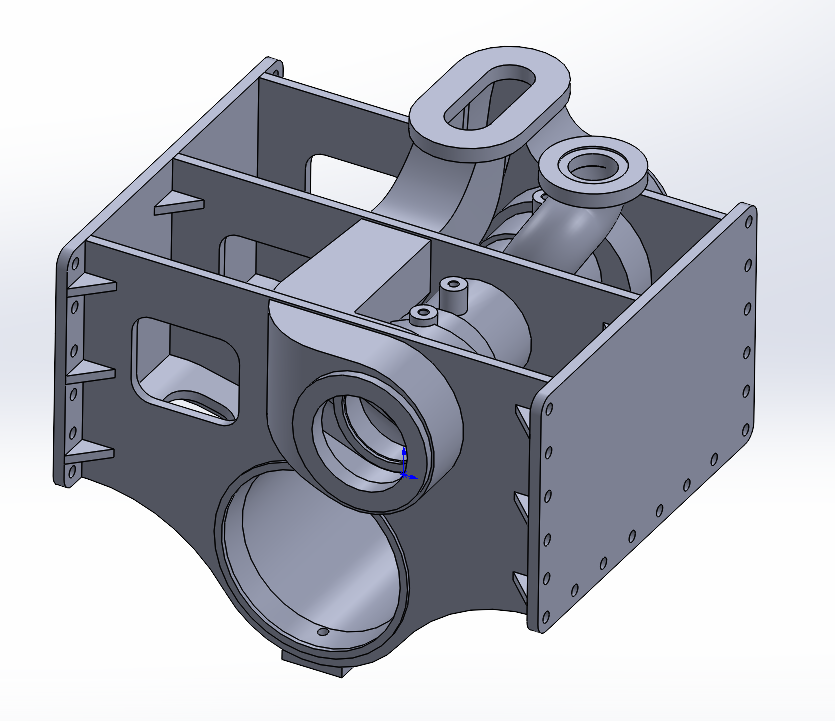 |
| Front LHS showing left hand cylinder and the proposed location of the air pump. | Front view showing all three cylinders. | Middle Cylinder |
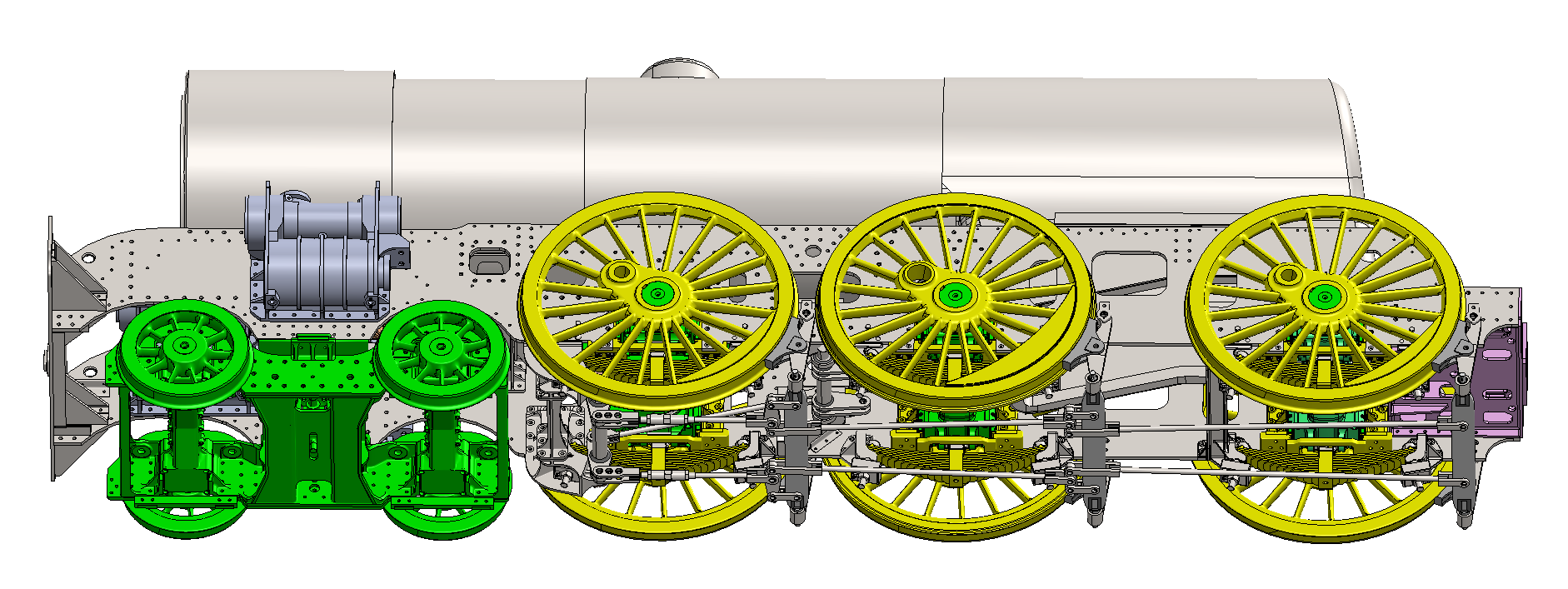 |
||
| Tilted view to show the location of the springs. | ||
 |
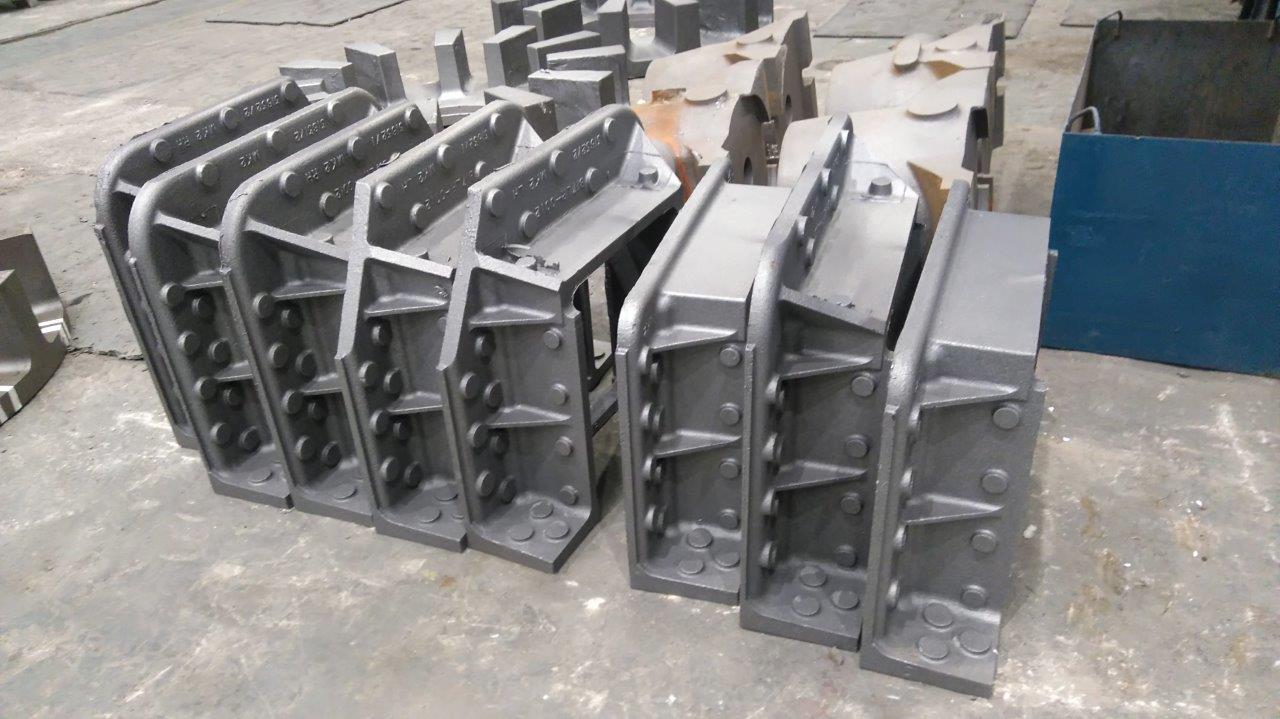 |
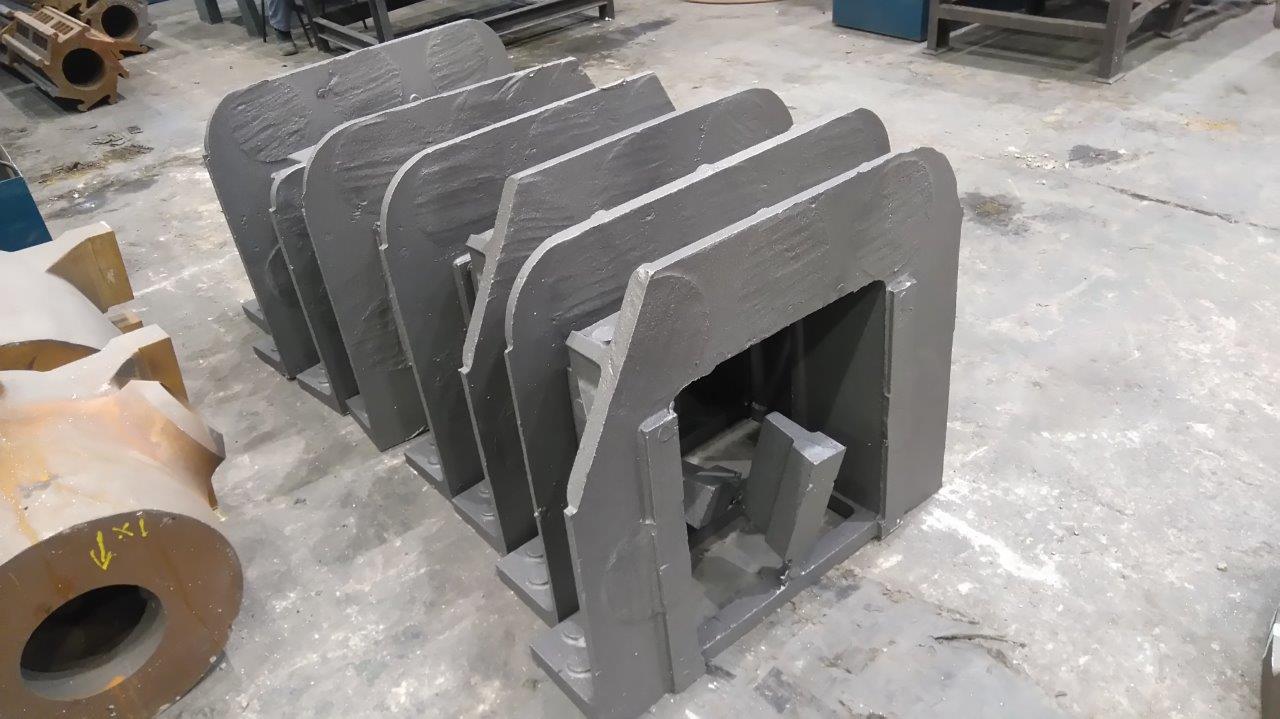 |
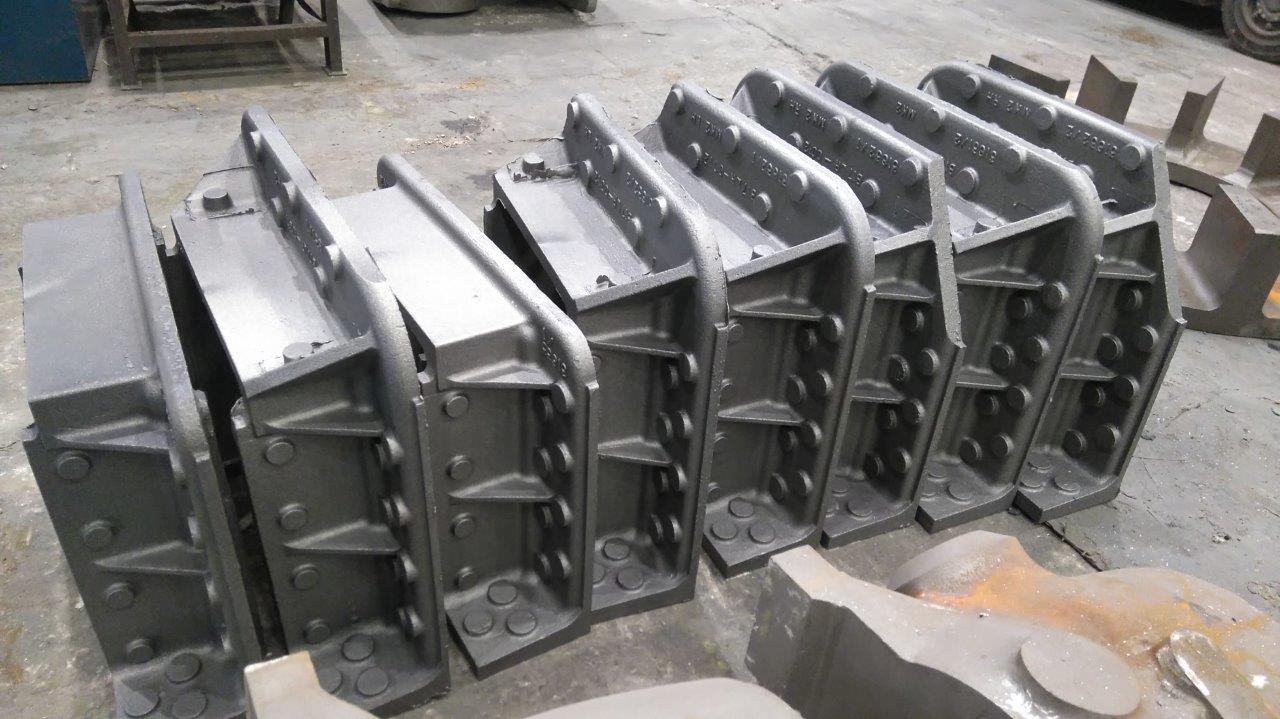 |
The Hornblock castings.The reason there are eight and not six is that a spare duplicate pair of hornblocks has been cast courtesy of William Cook and these will be used for preliminary set up trials and returned to them at some point.
